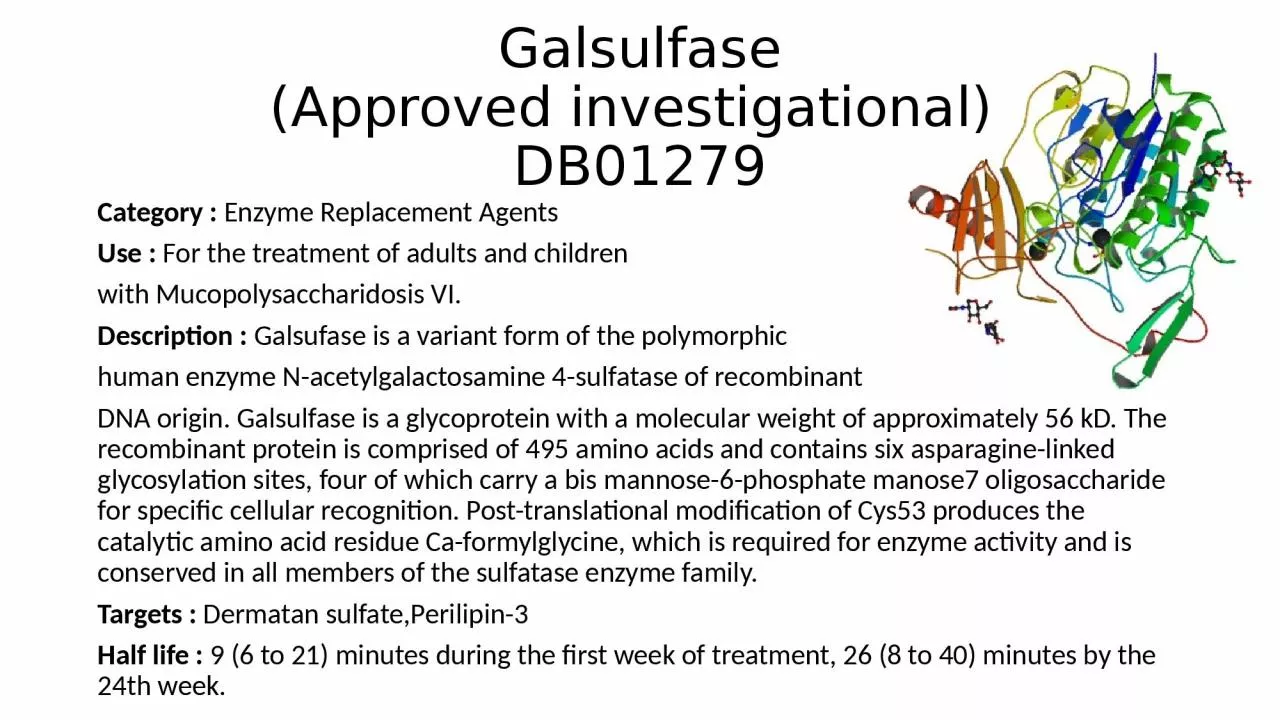

DB01279 Category Enzyme Replacement Agents Use For the treatment of adults and children with Mucopolysaccharidosis VI Description Galsufase is a variant form of the polymorphic ID: 916044
Download Presentation The PPT/PDF document "Galsulfase (Approved investigational)" is the property of its rightful owner. Permission is granted to download and print the materials on this web site for personal, non-commercial use only, and to display it on your personal computer provided you do not modify the materials and that you retain all copyright notices contained in the materials. By downloading content from our website, you accept the terms of this agreement.
Slide1
Galsulfase
(Approved investigational) DB01279
Category :
Enzyme Replacement Agents
Use
:
For the treatment of adults and children
with
Mucopolysaccharidosis
VI.
Description
:
Galsufase
is a variant form of the polymorphic
human
enzyme N-
acetylgalactosamine
4-sulfatase of recombinant
DNA
origin.
Galsulfase
is a glycoprotein with a molecular weight of approximately 56
kD
. The recombinant protein is comprised of 495 amino acids and contains six asparagine-linked glycosylation sites, four of which carry a
bis
mannose-6-phosphate manose7 oligosaccharide for specific cellular recognition. Post-translational modification of Cys53 produces the catalytic amino acid residue
Ca-formylglycine
, which is required for enzyme activity and is conserved in all members of the
sulfatase
enzyme family.
Targets :
Dermatan
sulfate,Perilipin-3
Half life
:
9 (6 to 21) minutes during the first week of treatment, 26 (8 to 40) minutes by the 24th week.
Slide2Pharmacodynamics :
Mucopolysaccharide storage disorders are caused by the deficiency of specific lysosomal enzymes required for the catabolism of GAG. Mucopolysaccharidosis VI (MPS VI, Maroteaux-Lamy syndrome) is characterized by the absence or marked reduction in N-acetylgalactosamine 4-sulfatase. The sulfatase activity deficiency results in the accumulation of the GAG substrate dermatan sulfate
, throughout the body. This accumulation leads to widespread cellular, tissue, and organ dysfunction.
Galsulfase
is intended to provide an exogenous enzyme that will be taken up into lysosomes and increase the catabolism of GAG.
Galsulfase
uptake by cells into lysosomes is most likely mediated by the binding of mannose-6-phosphate-terminated oligosaccharide chains of
galsulfase
to specific mannose-6-phosphate receptors.
Mechanism
of action
:
Galsulfase
supplies recombinant-engineered
galsulfase
, a normal variant form of the polymorphic human enzyme, N-
acetylgalactosamine
4-sulfatase. It is a
lysosomal
hydrolase that
catalyzes
the cleavage of the
sulfate
ester from terminal N-
acetylgalactosamine
4-sulfate residues of GAG chondroitin 4-sulfate and
dermatan
sulfate
. Increased catabolism of GAG in turn reduces systemic
dermatan
sulfate
accumulation, thereby reducing the primary symptoms of MPS VI.
Slide3Sequence :
SGAGASRPPHLVFLLADDLGWNDVGFHGSRIRTPHLDALAAGGVLLDNYYTQPLCTPSRSQLLTGRYQIRTGLQHQIIWPCQPSCVPLDEKLLPQLLKEAGYTTHMVGKWHLGMYRKECLPTRRGFDTYFGYLLGSEDYYSHERCTLIDALNVTRCALDFRDGEEVATGYKNMYSTNIFTKRAIALITNHPPEKPLFLYLALQSVHEPLQVPEEYLKPYDFIQDKNRHHYAGMVSLMDEAVGNVTAALKSSGLWNNTVFIFSTDNGGQTLAGGNNWPLRGRKWSLWEGGVRGVGFVASPLLKQKGVKNRELIHISDWLPTLVKLARGHTNGTKPLDGFDVWKTISEGSPSPRIELLHNIDPNFVDSSPCPRNSMAPAKDDSSLPEYSAFNTSVHAAIRHGNWKLLTGYPGCGYWFPPPSQYNVSEIPSSDPPTKTLWLFDIDRDPEERHDLSREYPHIVTKLLSRLQFYHKHSVPVYFPAQDPRCDPKATGVWGPWM Brand : BioMarin
Pharmaceuticals’s
Naglazyme
Indications :
NAGLAZYME (
galsulfase
) is indicated for patients
with
Mucopolysaccharidosis
VI (MPS VI,
Maroteaux-Lamy
syndrome). NAGLAZYME has been shown to improve walking and stair-climbing capacity.
Slide4NAGLAZYME
is a formulation of galsulfase, which is a purified human enzyme that is produced by recombinant DNA technology in a Chinese hamster ovary cell line. Galsulfase
(glycosaminoglycan N–
acetylgalactosamine
4-sulfatase, EC 3.1.6.12) is a
lysosomal
enzyme that
catalyzes
the cleavage of the
sulfate
ester from terminal N–
acetylgalactosamine
4-sulfate residues of
glycosaminoglycans
(GAG), chondroitin 4-sulfate and
dermatan
sulfate
.
Galsulfase
is a glycoprotein with a molecular weight of approximately 56
kDa
. The recombinant protein consists of 495 amino acids and possesses six asparagine-linked glycosylation sites, four of which carry a
bis
-mannose–6–phosphate residue for specific cellular recognition. Post-translational modification of Cys53 produces the catalytic amino acid residue, C
α-
formylglycine
, which is required for enzyme activity. NAGLAZYME has a specific activity of approximately 70 units per mg of protein content. One activity unit is defined as the amount of enzyme required to convert 1 micromole of 4-methylumbelliferyl
sulfate
to 4-methylumbelliferone and free
sulfate
per minute at
37°C. NAGLAZYME
is intended for intravenous infusion and is supplied as a sterile,
nonpyrogenic
,
colorless
to pale yellow, clear to slightly opalescent solution that must be diluted with 0.9% Sodium Chloride Injection, USP, prior to administration. NAGLAZYME is supplied in clear Type I glass 5 mL vials. Each vial provides 5 mg
galsulfase
, 43.8 mg sodium chloride, 6.20 mg sodium phosphate monobasic monohydrate, 1.34 mg sodium phosphate dibasic
heptahydrate
, and 0.25 mg
polysorbate
80 in a 5 mL extractable solution with pH of approximately 5.8. NAGLAZYME does not contain preservatives. Each vial is for single use only.
Slide5Dosage and administration :
The recommended dosage regimen of NAGLAZYME is 1 mg per kg of body weight administered once weekly as an intravenous infusion.Pretreatment with antihistamines with or without antipyretics is recommended 30 to 60 minutes prior to the start of the infusion. The total volume of the infusion should be delivered over a period of time of no less than 4 hours. NAGLAZYME should be diluted with 0.9% Sodium Chloride Injection, USP, to a final volume of 250 mL and delivered by controlled intravenous infusion using an infusion pump. The initial infusion rate should be 6 mL per hour for the first hour. If the infusion is well tolerated, the rate of infusion may be increased to 80 mL per hour for the remaining 3 hours. The infusion time can be extended up to 20 hours if infusion reactions occur.
For patients 20 kg and under or those who are susceptible to fluid volume overload, physicians may consider diluting NAGLAZYME in a volume of 100
mL.
The infusion rate (mL per hour) should be decreased so that the total infusion duration remains no less than 4 hours.
Each vial of NAGLAZYME provides 5 mg of
galsulfase
(expressed as protein content) in 5 mL of solution and is intended for single use only. Do not use the vial more than one time. The concentrated solution for infusion must be diluted with 0.9% Sodium Chloride Injection, USP, using aseptic techniques. Prepare
Naglazyme
using low-protein-binding containers and administer the diluted NAGLAZYME solution to patients using a low-protein-binding infusion set equipped with a low-protein-binding 0.2
μm
in-line filter. There is no information on the compatibility of diluted NAGLAZYME with glass containers.
Slide6General reference
: www.rxlist.comwww.drugbank.com